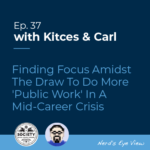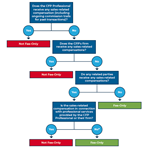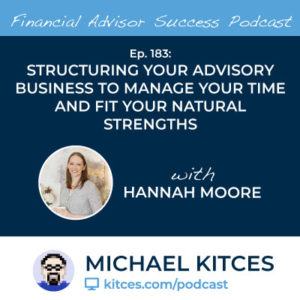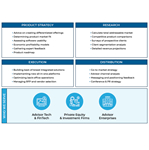No matter the industry or field, virtually all business owners have experienced the stress of just trying to stay afloat for the first (sometimes several) years of their existence. Those fortunate enough to get through those early ‘lean’ years, building a sustainable and growing business along the way, eventually feel a certain sense of relief when it’s clear they’ll “make it”, and the business can provide the income they hoped for in order to achieve their own personal goals. Yet at some point, many of those same entrepreneurs – including advisory firm owners – often then find themselves wondering “OK, but is this it?” or simply “what’s next?”… the proverbial “mid-life” (or at least, mid-career) crisis!
In our 37th episode of Kitces & Carl, Michael Kitces and financial advisor communication expert Carl Richards discuss how, at a certain point for many financial advisors, thoughts about the next stage in their careers and/or lives often turn towards expanding into wider circles and having a greater impact on the world around them…. even to the point of diminishing their involvement in the firm that they built but may no longer need to be as involved in to keep afloat.
However, the reality is that deciding on how to engage in more publicly focused work can be an overwhelming decision, as there is an endless number of ways to go about doing so, from writing books to speaking to volunteering and other ways to give back. By intentionally working on developing clarity and finding focus, though, financial advisors can begin to identify their best ideas and choose specific areas they want to act on. And allowing oneself flexibility is also important, because even as values and priorities may shift and evolve over time, so too should advisors’ long-term (and shorter-term) points of focus.
Vision statements – often used in the context of the business – can be used by advisors as personal statements of purpose, and become instrumental as “filters” for financial advisors who may feel overwhelmed by an abundance of potential ideas. As while individuals who are successful will tend to find more opportunities to choose from, making a decision that resonates with their values and priorities can be difficult without a clear vision of the direction in which they truly want to go.
Ultimately, the key point is that financial advisors who may be faced with a mid-career crisis of uncertainty, and who are having difficulty deciding how to choose the next step in their lives, may benefit from creating a vision statement based on their own true ‘why’. As while having a clear understanding of what’s most important in one’s life can serve as an effective funneling tool to rule out ideas that may simply sound good, but don’t really resonate with the advisor’s true goals, a good vision statement can keep an individual on target for what really matters most to them!






 Welcome back to the 183rd episode of Financial Advisor Success Podcast!
Welcome back to the 183rd episode of Financial Advisor Success Podcast!



